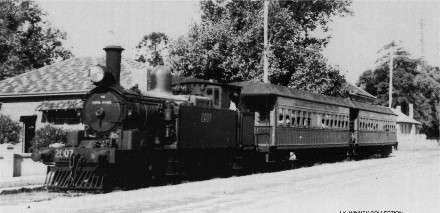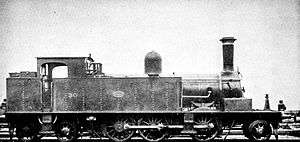New South Wales Z20 class locomotive
|
Class Z20 Locomotive in service | |||||||||||||||||||||||||||||
| |||||||||||||||||||||||||||||
| |||||||||||||||||||||||||||||
| |||||||||||||||||||||||||||||
| |||||||||||||||||||||||||||||
The Z20 class (formerly E.10 and A/E class) is a class of steam locomotive built for and operated by the New South Wales Government Railways of Australia.[1][2][3]
History

_locomotive_(5666862850).jpg)
There was a total of 33 members of this class of 2-6-4T mixed traffic side tank locomotives. There were three differing types.
Twelve were classified E(10) class under the pre-1924 recording. These locomotives were built by Beyer, Peacock and Company and delivered in 1891 for use on Newcastle coal traffic. They proved very successful in suburban goods and coal traffic, but were unsuited to main line passenger traffic. When displaced by more powerful locomotives, many were used as shunters. Their final services were on short light branch lines, such as Richmond-Kurrajong, Carlingford, Camden, Rogans Hill and Morpeth. A number were also to be found shunting the industrial sidings at Port Kembla.[4][5]
In 1902 there was a shortage of tank locomotives. Six members of the A(93) class 0-6-0 tender engines were converted to a new A/E class tank locomotives by Eveleigh Railway Workshops. A further eight conversions were made in 1909/10. In 1911 seven new locomotives were constructed at Eveleigh. In 1924, these 21 locomotives were grouped with the twelve E(10) class to form the (Z)20-class.[6]
Later Years
As more tender locomotives became available for suburban goods traffic, the surplus locomotives of the combined class were scrapped or sold. Some of the locomotives which were sold to industrial interests include:
- 2002 to the NSW Public Works Department (renumbered PWD80)
- 2003, 2004 and 2012 to Australian Iron & Steel, Port Kembla
- 2008 to the Electrolytic Refining & Smelting Company, Port Kembla
- 2013 to Widemere Quarry, Fairfield resold to J&A Brown Abermain Seaham Collieries, Hexham
- 2017 and 2020 to Hebburn Collieries, Weston
- 2014 to Bunnerong Power Station
- 2031 to Bulli Colliery
The last member of the class in service with the New South Wales Government Railways was 2029 which had been retained for working the Liverpool to Moorebank branch. This has been preserved by the New South Wales Rail Transport Museum, Thirlmere and cosmetically restored.[7]
Preservation
| Preserved Z20 Class Locomotives | ||||||||
|---|---|---|---|---|---|---|---|---|
| No. | Description | Manufacturer | Year | Current Organisation | Location | Status | Ref | |
| 2029 | 2-6-4T passenger | Eveleigh Railway Workshops | 1911 | NSW Rail Transport Museum | Thirlmere | static exhibit | NSW Locomotive, Steam 2029 | |
See also
References
- ↑ Preston, Ron G (1984). Tender into Tank. Sydney: New South Wales Rail Transport Museum. pp. 11–57. ISBN 0 909862 18 4.
- ↑ Grunbach, Alex (1989). A Compendium of New South Wales Steam Locomotives. Sydney: Australian Railway Historical Society, NSW Division. pp. 41–45. ISBN 0 909650 27 6.
- ↑ New South Wales Railways 1855-1955. Published by Department of Railways
- ↑ Preston, Ron G (1984). Tender into Tank. Sydney: New South Wales Rail Transport Museum. pp. 151–199. ISBN 0 909862 18 4.
- ↑ Grunbach, Alex (1989). A Compendium of New South Wales Steam Locomotives. Sydney: Australian Railway Historical Society, NSW Division. pp. 92–93, 138–139. ISBN 0 909650 27 6.
- ↑ Oberg, Leon (1984). Locomotives of Australia 1850's - 1980's. Frenchs Forest: Reed Books. p. 36. ISBN 0 730100 05 7.
- ↑ Locomotive, Steam 2029 Department of Environment & Heritage
